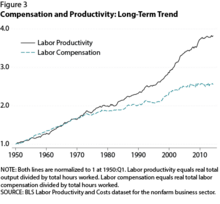
Back أجر حقيقي Arabic Reálná mzda Czech Reallohn German Salario real Spanish دستمزد واقعی Persian Reaalipalkka Finnish שכר ריאלי HE Reálbér Hungarian Իրական աշխատավարձ Armenian 実質賃金 Japanese
This article has multiple issues. Please help improve it or discuss these issues on the talk page. (Learn how and when to remove these messages)
|


Real wages are wages adjusted for inflation, or equivalently wages in terms of the amount of goods and services that can be bought. This term is used in contrast to nominal wages or unadjusted wages. Because it has been adjusted to account for changes in the prices of goods and services, real wages provide a clearer representation of an individual's wages in terms of what they can afford to buy with those wages – specifically, in terms of the amount of goods and services that can be bought; however, real wages suffer the disadvantage of not being well defined, since the amount of inflation (which can be calculated based on different combinations of goods and services) is itself not well defined. Hence real wage defined as the total amount of goods and services that can be bought with a wage, is also not defined. This is because of changes in the relative prices.
Despite difficulty in defining one value for the real wage, in some cases a real wage can be said to have unequivocally increased. This is true if: After the change, the worker can now afford any bundle of goods and services that they could just barely afford before the change, and still have money left over. In such a situation, real wage increases no matter how inflation is calculated. Specifically, inflation could be calculated based on any good or service or combination thereof, and real wage has still increased. This of course leaves many scenarios where real wage increasing, decreasing or staying the same depends upon how inflation is calculated. These are the scenarios where the worker can buy some of the bundles that they could just barely afford before and still have money left, but at the same time they simply cannot afford some of the bundles that they could before. This happens because some prices change more than others, which means relative prices have changed.
The use of adjusted figures is used in undertaking some forms of economic analysis. For example, to report on the relative economic successes of two nations, real wage figures are more useful than nominal figures. The importance of considering real wages also appears when looking at the history of a single country. If only nominal wages are considered, the conclusion has to be that people used to be significantly poorer than today. However, the cost of living was also much lower. To have an accurate view of a nation's wealth in any given year, inflation has to be taken into account and real wages must be used as one measuring stick. There are further limitations in the traditional measures of wages, such as failure to incorporate additional employment benefits, or not adjusting for a changing composition of the overall workforce.[1]
An alternative is to look at how much time it took to earn enough money to buy various items in the past, which is one version of the definition of real wages as the amount of goods or services that can be bought. Such an analysis shows that for most items, it takes much less work time to earn them now than it did decades ago, at least in the United States.[2]
- ^ The Council of Economic Advisers (September 2018). "How Much Are Workers Getting Paid? A Primer on Wage Measurement" (PDF). whitehouse.gov – via National Archives.
- ^ "Time Well Spent: The Declining Real Cost of Living in America" by W. Michael Cox and Richard Alm, pp. 2–24 of the 1997 Annual Report of the Federal Reserve Bank of Dallas.